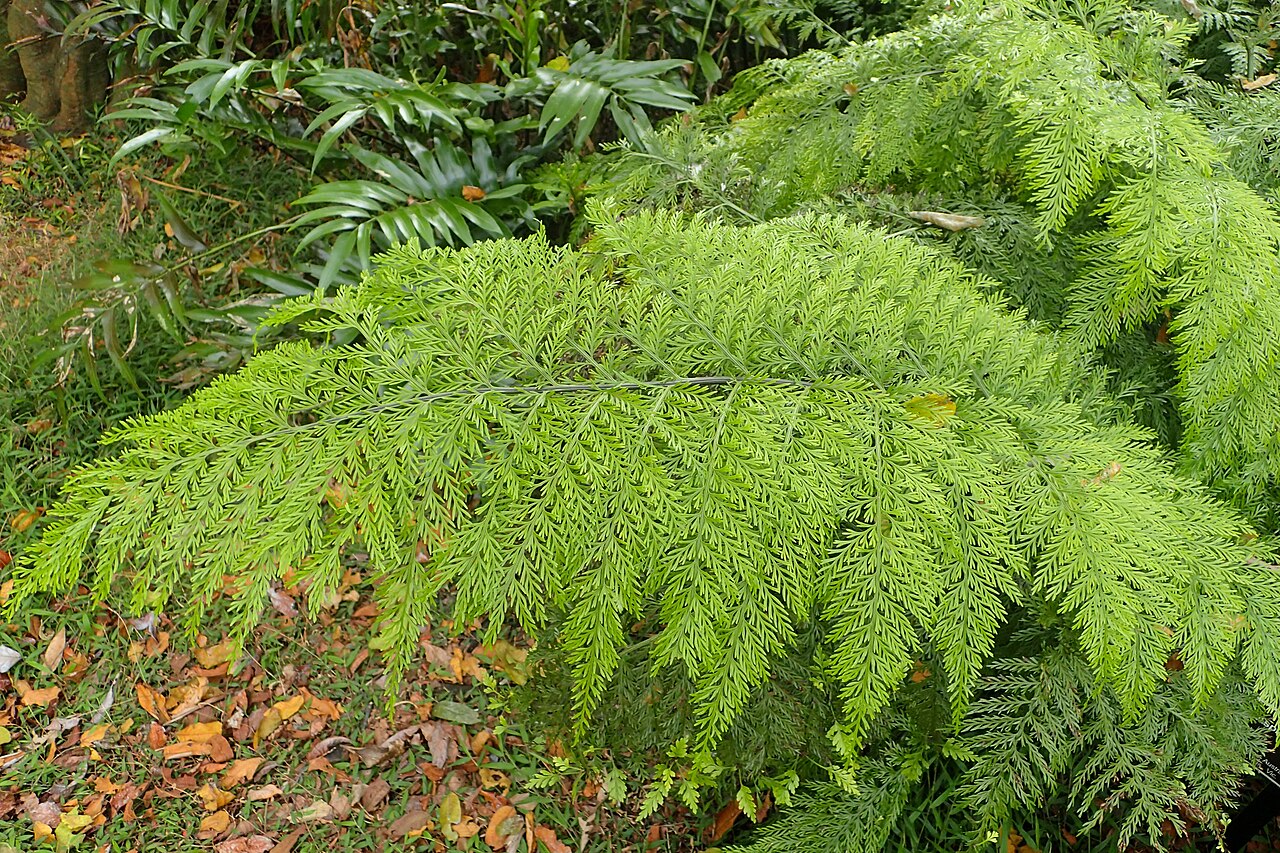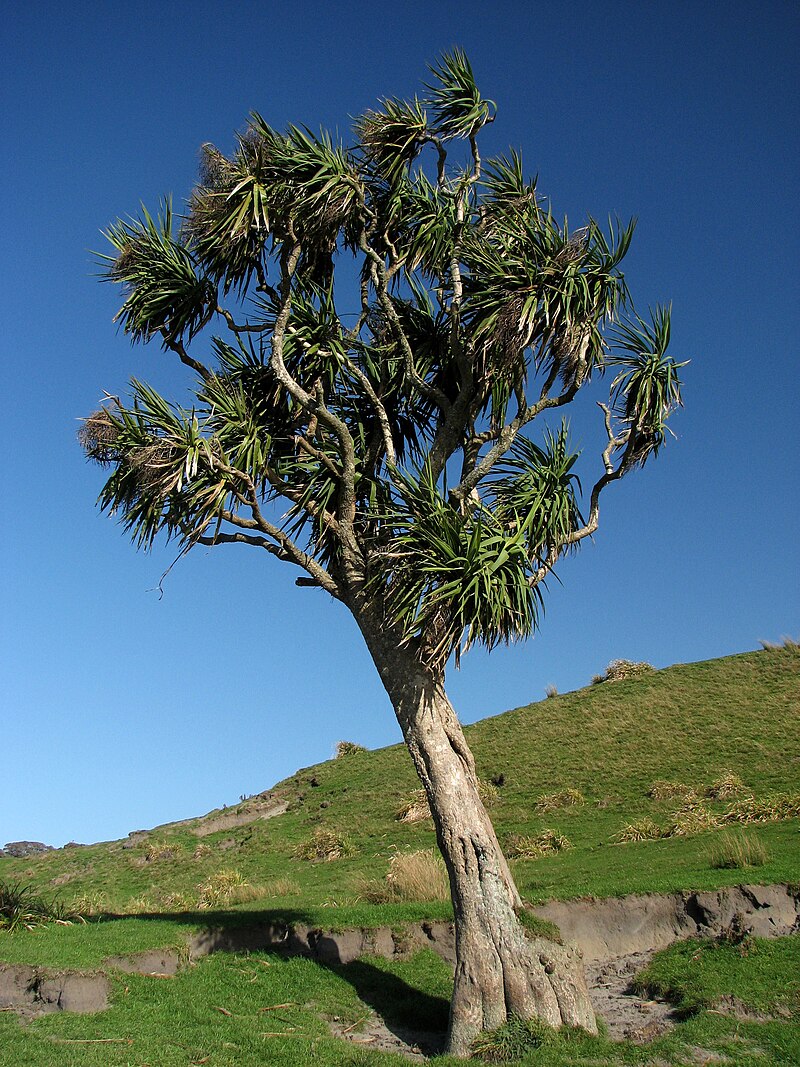Silver Fern (Ponga)
Cyathea dealbata
The Silver Fern (Cyathea dealbata) is one of New Zealand's most iconic plants and recognized as an unofficial national emblem. This elegant tree fern is prized for its distinctive fronds with striking silver undersides that shimmer in forest light. Known as 'ponga' in te reo Māori, this fern species has become synonymous with New Zealand identity, featuring on sports teams' uniforms, military insignia, and countless national symbols.

Image credit: Silver Fern (Cyathea dealbata) showing the distinctive silver-white underside of fronds. Image: Alsophila tricolor kz03 by Kznf [CC BY-SA 4.0], via Wikimedia Commons
Quick Facts
| Height | 5-10 meters |
|---|---|
| Water Needs | Moderate to High |
| Light | Partial to Full Shade |
| Frost Tolerance | Moderate |
| Growth Rate | Slow |
| Lifespan | Several decades |
Climate Best Suited To
Silver Ferns thrive in New Zealand's cool, moist forest environments where they receive filtered light and protection from harsh elements. These iconic tree ferns have specific climate preferences:
- Temperature: Prefers mild, temperate conditions with average temperatures between 5-25°C (41-77°F). Can tolerate brief periods below freezing but requires protection in areas with sustained frosts.
- Moisture: Requires consistent moisture and humidity. Does best in environments with regular rainfall or irrigation, particularly during establishment and dry periods.
- Light: Naturally grows under the dappled shade of forest canopies. Prefers morning sun with afternoon shade, or filtered light throughout the day. Direct harsh sunlight can scorch fronds, especially in warmer regions.
- Wind: Prefers sheltered locations protected from strong, drying winds which can damage the delicate fronds and increase water loss.
- Soil: Thrives in humus-rich, slightly acidic soil that retains moisture while still offering good drainage. Forest floor conditions with deep organic matter are ideal.
Regional Suitability
| City | Climate Suitability |
|---|---|
| Whangārei | Ideal |
| Auckland | Ideal |
| Hamilton | Ideal |
| Tauranga | Ideal |
| Rotorua | Ideal |
| Gisborne | Ideal |
| New Plymouth | Ideal |
| Napier | Good |
| Whanganui | Ideal |
| Palmerston North | Ideal |
| Wellington | Ideal |
| Nelson | Good |
| Christchurch | Moderate |
| Dunedin | Good |
| Queenstown | Challenging |
| Invercargill | Moderate |
For best results in drier regions, create a microclimate by planting in sheltered, shaded areas near other moisture-retaining plants. Regular mulching and consistent watering will help overcome climatic limitations.

Native distribution of Silver Fern (Cyathea dealbata) across New Zealand
Growth Habit
The Silver Fern is a tree fern with a distinctive growth habit:
- Form: Upright and architectural, with a single unbranched trunk topped by an elegant crown of arching fronds.
- Trunk: The trunk (technically called a caudex or rhizome) grows slowly, typically 10-15cm per year, and is covered with leaf bases and brown scales.
- Fronds: The large, triangular, bipinnate fronds grow in a symmetrical crown at the top of the trunk. New fronds emerge in a tight spiral (koru) before unfurling.
- Distinctive Feature: The silver-white underside of the fronds contrasts dramatically with the dark green upper surface, creating a striking effect when viewed from below or when fronds move in the breeze.
- Root System: Shallow, fibrous root system that spreads horizontally rather than deeply.
In the wild, Silver Ferns often grow in groups in sheltered forest understories, creating a striking architectural element in native bush settings. As they mature, older fronds die and hang down along the trunk before eventually falling off.
Propagation
Propagating Silver Fern can be challenging but rewarding:
From Spores
The most common method of propagation is from spores:
- Collect mature spores from the undersides of fronds when the spore cases turn brown.
- Sow spores on sterile, moist peat/sand mix or commercial seed raising mix.
- Cover container with glass or plastic to maintain humidity.
- Keep at 18-21°C and in indirect light.
- Germination may take 1-6 months, producing a green film (prothalli).
- After several more months, tiny fern fronds will appear.
- When plants have several fronds, carefully transplant to individual pots.
Division
Mature plants occasionally produce offshoots:
- Wait until the offset is at least 10-15cm tall with several fronds.
- Carefully cut the offset away from the parent plant with a sharp, sterile knife.
- Ensure the offset has some roots attached.
- Plant immediately in a sheltered spot with high humidity.
Note: Propagation from spores requires patience as Silver Ferns grow slowly. It may take 5+ years to develop a small trunk.
Planting and Care
Planting
- When to Plant: Best planted in spring or autumn to avoid temperature extremes.
- Location: Choose a sheltered spot with dappled light or morning sun and afternoon shade.
- Soil Preparation: Incorporate plenty of organic matter (leaf mold, compost) into planting hole.
- Spacing: Allow 1-2 meters between plants for proper air circulation.
- Depth: Plant at the same level as it was in its container, never burying the crown.
Watering
- Keep soil consistently moist, especially during establishment and dry periods.
- Water deeply once or twice a week rather than frequent shallow waterings.
- Mist fronds regularly in dry weather to increase humidity.
- Apply a layer of mulch to retain soil moisture and suppress weeds.
Fertilizing
- Apply a slow-release native plant fertilizer in spring.
- Alternatively, use liquid seaweed fertilizer diluted to half strength every 6-8 weeks during growing season.
- Avoid high-nitrogen fertilizers which can cause weak growth.
Maintenance
- Remove dead or damaged fronds at the base to keep the plant tidy.
- Protect from strong winds which can damage fronds and dry out the plant.
- Apply a fresh layer of mulch annually in spring.
- Consider wrapping the trunk with frost cloth in areas prone to hard frosts.
Cultural Significance
The Silver Fern holds immense cultural importance in New Zealand:
Māori Significance
- Known as 'ponga' or 'kaponga' in te reo Māori.
- Used traditionally as a navigational aid - the silver underside of fronds reflects moonlight, helping to illuminate forest paths at night.
- Young shoots (koru) were sometimes eaten, and the pith of the trunk used as a food source in times of scarcity.
- Trunks were used to mark boundaries and create walls for storage pits.
- The distinctive koru (unfurling frond) symbolizes new life, growth, strength, and peace.
National Symbol
- Adopted as an unofficial national emblem since the 1880s.
- Features on the logo of many national sports teams, most notably the All Blacks rugby team.
- Used on New Zealand military badges since the South African War.
- Appears on numerous commercial logos, government documents, and the national coat of arms.
- Considered alongside the kiwi as one of New Zealand's most recognized symbols internationally.
The Silver Fern's cultural significance extends beyond symbology, representing New Zealand's unique ecological heritage and connection to the land. Its enduring popularity as a national symbol speaks to its distinctive beauty and deep cultural resonance.
Landscaping Uses
The Silver Fern offers numerous landscaping possibilities:
- Shade Gardens: Ideal specimen plant for woodland gardens or shaded areas.
- Native Plantings: Essential component of New Zealand native garden designs.
- Architectural Element: Striking vertical accent in garden compositions.
- Underplanting: Works well beneath tall trees that provide dappled shade.
- Container Growing: Younger specimens can be grown in large containers in sheltered positions.
- Indoor Feature: In suitable climates, can be grown indoors in large containers with sufficient humidity.
- Restoration Projects: Valuable component in native forest regeneration initiatives.
Companion Plants
Silver Fern pairs beautifully with other New Zealand natives including:
- Astelia species (bush flax)
- Coprosma varieties (especially those with glossy leaves)
- Fuchsia excorticata (tree fuchsia)
- Pittosporum tenuifolium (kohuhu)
- Podocarpus tōtara (tōtara)
- Other native ferns such as Blechnum species
When designing with Silver Fern, consider its dramatic silhouette and the stunning effect of light on its silver undersides. Position where this feature can be appreciated, such as along pathways or viewed from below.
Pests and Diseases
Silver Ferns are generally resilient but can face several challenges:
Common Pests
- Scale Insects: Appear as small bumps on fronds. Control with horticultural oil or insecticidal soap.
- Mealy Bugs: White, cottony clusters that can infest new growth. Remove with cotton swab dipped in alcohol or use insecticidal soap.
- Slugs and Snails: Can damage new fronds. Use barriers or environmentally friendly baits.
- Caterpillars: Occasionally feed on fronds. Remove by hand or use organic Bacillus thuringiensis spray if infestation is severe.
Diseases
- Root Rot: Caused by overwatering or poor drainage. Ensure planting site has good drainage and avoid overwatering.
- Frond Spot: Various fungal diseases can cause spotting on fronds. Improve air circulation and avoid overhead watering.
- Crown Rot: Can occur in excessively wet conditions. Ensure crown isn't buried and avoid water pooling around the base.
Environmental Issues
- Sunburn: Direct sun can scorch fronds. Move to a more shaded location if fronds show yellowing or browning.
- Frost Damage: While somewhat frost tolerant, severe frosts can damage fronds. Protect with frost cloth in colder regions.
- Wind Damage: Strong winds can shred fronds. Plant in sheltered locations or provide wind protection.
- Dehydration: Low humidity and dry conditions can cause frond tips to brown. Increase humidity by misting regularly.
Prevention is key to maintaining healthy Silver Ferns. Ensure proper growing conditions with adequate shade, consistent moisture, and good air circulation to minimize pest and disease issues.
Seasonal Care Guide
Spring
- Apply slow-release fertilizer as new growth begins.
- Refresh mulch layer around the base, keeping it away from the crown.
- Remove any winter-damaged fronds.
- Ideal time for planting new specimens.
- Collect spores for propagation as they mature.
- Increase watering as temperatures rise.
Summer
- Maintain consistent moisture through regular deep watering.
- Mist fronds during hot, dry periods to increase humidity.
- Provide shade protection during the hottest part of the day.
- Monitor for pests, especially during dry weather.
- Apply liquid seaweed fertilizer if growth seems sluggish.
Autumn
- Good time for planting before winter sets in.
- Reduce fertilizing as growth slows.
- Clean up any fallen fronds to prevent disease.
- Prepare for winter by ensuring adequate mulch is in place.
- Consider moving container specimens to more sheltered positions.
Winter
- Reduce watering frequency but don't allow to dry out completely.
- Protect from hard frosts with frost cloth if necessary.
- Avoid removing old fronds which can provide some frost protection.
- Keep fallen leaves and debris clear from the crown to prevent rot.
- If growing in containers, ensure they don't become waterlogged.
Ecological Impact
Silver Ferns play an important role in New Zealand's forest ecosystems:
- Forest Structure: Contribute to the understory layer of native forests, adding to biodiversity and structural complexity.
- Habitat Provision: The moist, shaded areas around Silver Ferns provide habitat for native insects, fungi, and small creatures.
- Soil Stability: Their fibrous root systems help stabilize soil on forest floors and hillsides.
- Nutrient Cycling: Decaying fronds add organic matter to the forest floor, contributing to nutrient cycling.
- Indicator Species: The presence of healthy Silver Ferns often indicates a well-functioning forest ecosystem with appropriate moisture levels and shade.
- Succession Role: Play a role in forest succession, helping create conditions for other shade-loving species.
In garden settings, Silver Ferns can help create microclimates that support other moisture-loving natives and increase local biodiversity. When planted in appropriate conditions, they require minimal intervention and are an environmentally responsible choice for New Zealand gardens.
As climate change impacts New Zealand's forests, protecting established populations of Silver Ferns and other native species becomes increasingly important for maintaining ecosystem health and resilience.
Bonus Tip
To create a striking night garden feature with your Silver Fern:
Install subtle upward-facing landscape lighting beneath or near your Silver Fern. After dark, the light will illuminate the silver undersides of the fronds, creating a magical moonlit effect. This not only showcases the fern's most distinctive feature but also references its traditional use by Māori as a natural nighttime path marker.
For an authentic New Zealand forest garden, combine several Silver Ferns with other native understory plants, add a small water feature for increased humidity, and create a winding path that allows visitors to walk beneath the fronds and look up at their silvery undersides – mimicking the experience of walking through a New Zealand bush track.


